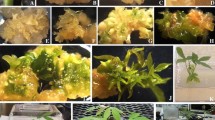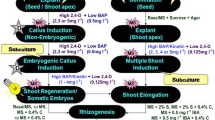Abstract
Sugarcane is an important domestic and industrial crop and considerable efforts have been made to improve its yield through conventional as well as biotechnological approaches. Genetic manipulation of sugarcane is dependent on an efficient reproducible in vitro regeneration regime. In the current study, the role of explant position, induced desiccation, picloram (PIC) levels for callogenesis as well as thidiazuron (TDZ) addition during regeneration phase has been appraised. Using an optimum combination of mentioned factors, an enhanced in vitro regeneration system has been established for two elite sugarcane cultivars. Embryogenesis was stimulated in cv. HSF-240 by MS medium augmented with 12.42 μM PIC while cv. CPF-237 exhibited sometic embryo formation when PIC supplementation was combined with induced desiccation (using 12 g L–1 agar). A decrease in embryogenesis frequency was recorded from base towards tip. The explants cultured alternately on high (12.42 μM) and low (4.14 μM) PIC medium produced the highest number of nodular calli which later exhibited maximum regeneration potential. Optimal shoot initiation was observed with 9.08 μM TDZ followed by medium having 2.27 μM 2,4-dichlorophenoxyacetic acid plus 4.43 μM benzylaminopurine. However, the shoots produced with former medium composition showed frailty as compared to the one regenerated on later medium. Healthy roots were initiated with 16.11 μM naphthalene acetic acid in the presence of 0.5% activated charcoal. Malondialdehyde content, catalase and peroxidase activity of in vitro and field grown sugarcane plants were analogous, indicating that the in vitro regenerated plants were equally fit for subsequent growth in natural conditions. The reported protocol can be helpful in devising strategies for a robust sugarcane genetic engineering regime.






Similar content being viewed by others
REFERENCES
Aebi, H., Catalase in vitro, Methods Enzymol., 1984, vol. 105, pp. 121–126.
Aftab, F. and Iqbal, J., Plant regeneration from protoplasts derived from cell suspension of adventive somatic embryos in sugarcane (Saccharum sp hybrid cv CoL-54 and cv CP-43/33), Plant Cell Tiss. Organ Cult., 1999, vol. 56, pp. 155–162.
Aftab, F., Zafar, Y., Malik, K.A., and Iqbal, J., Plant regeneration from embryogenic cell suspensions and protoplasts in sugarcane (Saccharum spp. hybrid cv CoL-54), Plant Cell Tiss. Organ Cult., 1996, vol. 44, pp. 71–78.
Ali, A., Naz, S., Siddiqui, F.A., and Iqbal, J., Rapid clonal multiplication of sugarcane (Saccharum officinarum) through callogenesis and organogenesis, Pak. J. Bot., 2008, vol. 40, pp. 123–138.
Altpeter, F., Baisakh, N., Beachy, R., Bock, R., Capell, T., Christou, P., Daniell, H., Datta, K., Datta, S., Dix, P.J., Fauquet, C,et al., Particle bombardment and the genetic enhancement of crops: myths and realities, Mol. Breed., 2005, vol. 15, pp. 305–327.
Chance, B. and Maehly, A.C., Assay of catalases and peroxidases, Methods Enzymol., 1955, vol. 2, pp. 764–775.
Charleson, R.P., Stephen, C.W., and Matthew, A.J., Adventitious shoot regeneration of scotch spearmint (Mentha x Gracilis Sole), In Vitro Cell. Dev. Biol.–Plant, 2006, vol. 42, pp. 354–358.
Chengalrayan, K. and Gallo-Meagher, M., Effect of various growth regulators on shoot regeneration of sugarcane, In Vitro Cell. Dev. Biol.–Plant, 2001, vol. 37, pp. 434–439.
Chengalrayan, K., Abouzid, A., and Gallo-Meagher, M., In vitro regeneration of plants from sugarcane seed derived callus, In Vitro Cell. Dev. Biol–Plant, 2005, vol. 41, pp. 477–482.
Croft, B.J., Magarey, R.C., Allsopp, P.G., Cox, M.C., Willcox, T.G., Milford, B.J., Wal, E.S., et al., Sugarcane smut in Queensland: arrival and emergency response, Austral. Plant Pathol., 2001, vol. 37, pp. 26–34.
Dhawan, A.K., Moudgil, R., Dendsay, J.P.S., and Mandhan, R.P., Low thidiazuron levels promote and sustain shootlet multiplication in sugarcane, Ind. J. Plant Physiol., 2004, vol. 9, pp. 354–359.
Economic Survey of Pakistan, Government of Pakistan, Ministry of Food and Agriculture Islamabad, 2017-18.
Gallomeagher, M., English, R.G., and Abouzid, A., Thidiazuron stimulates shoot regeneration of sugarcane embryogenic callus, In Vitro Cell. Dev. Biol.–Plant, 2000, vol. 36, pp. 37–40.
Garcia, R., Cidade, D., Castellar, A., Lip, A., Magioli, C., Callado, C., and Mansur, E., In vitro morphogenesis patterns from shoot apices of sugar cane are determined by light and type of growth regulator, Plant Cell Tiss. Organ Cult., 2007, vol. 90, pp. 181–190.
Gill, R., Malhotra, P.K., and Gosal, S.S., Direct plant regeneration from cultured young leaf segments of sugarcane, Plant Cell Tiss. Organ Cult., 2006, vol. 84, pp. 100205–100209.
Grossmann, K., Mode of action of auxin herbicides: a new ending to a long, drawn out story, Trends Plant Sci., 2000, vol. 5, pp. 506–509.
Heath, R.L. and Packer, L., Photoperoxidation in isolated chloroplasts: kinetics and stoichiometry of fatty acid peroxidation, Arch. Biochem. Biophys., 1968, vol. 125, pp. 189–198.
Hotta, C.T., Lembke, C.G., Domingues, D.S., et al., The biotechnology roadmap for sugarcane improvement, Trop. Plant Biol., 2010, vol. 3, pp. 75–87.
Jain, M., Chengalrayan, K., Abouzid, A., and Gallo-Meagher, M., Prospecting the utility of a PMI/mannose selection system for the recovery of transgenic sugarcane (Saccharum sp. hybrid) plants, Plant Cell Rep., 2007, vol. 26, pp. 581–590.
Kaur, A. and Gosal, S.S., Desiccation of callus enhances somatic embryogenesis and subsequent shoot regeneration in sugarcane, Ind. J. Biotechnol., 2009, vol. 8, pp. 332–334.
Kaur, R. and Kapoor, M., Plant regeneration through somatic embryogenesis in sugarcane, Sugar Tech., 2016, vol. 18, pp. 93–99.
Kumari, K., Lal, M., and Saxena, S., Enhanced micropropagation and tiller formation in sugarcane through pretreatment of explants with thidiazuron (TDZ), Biotech., 2017, vol. 7, p. 282.
Lakshmanan, P., Geijskes, R.J., Aitken, K.S., Grof, C.L.P., Bonnett, G.D., and Smith, G.R., Sugarcane biotechnology: the challenges and opportunities, In Vitro Cell. Dev. Biol.–Plant, 2005, vol. 41, pp. 345–363.
Lakshmanan, P., Geijskes, R.J., Wang, L.F., Elliott, A., Grof, C.P.L., Berding, N., and Smith, G.R., Developmental and hormonal regulation of direct shoot organogenesis and somatic embryogenesis in sugarcane (Saccharum sp interspecific hybrids) leaf culture, Plant Cell Rep., 2006, vol. 5, pp. 1007–1015.
Mamun, M.A., Sikdar, M.B.H., Paul, D.K., Rahman, M.M., and Islam, M.R., In vitro micropropagation of some important sugarcane varieties of Bangladesh, Asian J. Plant Sci., 2004, vol. 3, pp. 666–669.
Munir, N. and Aftab, F., The role of polyethylene glycol (PEG) pretreatment in improving sugarcane’s salt (NaCl) tolerance, Turk. J. Bot., 2009, vol. 33, pp. 407–415.
Murashige, T. and Skoog, F., A revised medium for rapid growth and bioassays with tobacco tissue culture, Physiol. Plant., 1962, vol. 15, pp. 473–497.
Ramanand Kureel, N., Subhanand, N., Lal, M., and Singh, S.B., Plantlet regeneration through leaf callus culture in sugarcane, Sugar Tech., 2006, vol. 8, pp. 85–87.
Rikiishi, K., Matsuura, T., Maekawa, M., and Takeda, K., Light control of shoot regeneration in callus cultures derived from barley (Hordeum vulgare L.) immature embryos, Breed Sci., 2008, vol. 58, pp. 129–135.
Snyman, S.J., Meyer, G.M., Richards, J.M., Haricharan, N., Ramgareeb, S., and Huckett, B.I., Refining the application of direct embryogenesis in sugarcane: effect of the developmental phase of leaf disc explants and the timing of DNA transfer on transformation efficiency, Plant Cell Rep., 2006, vol. 25, pp. 1016–1023.
Taiz, L. and Zeiger, E., Plant Physiology, Sunderland Massachusetts, USA: Sinauer Associates Inc., 2010, 5th ed.
Thomas, T.D., The role of activated charcoal in plant tissue culture, Biotechnol. Adv., 2008, vol. 26, pp. 618–631.
Tiel, K., Enríquez, G.A., Ceballo, Y., Soto, N., Fuentes, A.D., Ferreira, A., Coll, Y., and Pujol, M., Development of a system for rapid plant regeneration from in vitro sugarcane (Saccharum officinarum L.) meristematic tissue, Biotecnol. Appl., 2006, vol. 23, pp. 22–24.
ACKNOWLEDGMENTS
We are greatly thankful to Dr. Shahid Afghan, Ayub Agricultural Research Institute Faisalabad, for provision of sugarcane germplasm used in the current study.
Author information
Authors and Affiliations
Contributions
JI perceived the idea/s and MSA executed the experiments. MS and AKA helped in statistical analysis of the data and preparation of the manuscript. All the authors read/approved the manuscript for submission.
Corresponding author
Ethics declarations
The authors declare that they have no conflict of interests. This article does not contain any studies involving animals or human participants performed by any of the authors.
About this article
Cite this article
Akram, M.S., Alvi, A.K. & Iqbal, J. Enhanced in vitro Regeneration in Sugarcane (Saccharum officinarum L.) by Use of Alternate High-Low Picloram Doses and Thidiazuron Supplementation. Cytol. Genet. 55, 566–575 (2021). https://doi.org/10.3103/S0095452721060025
Received:
Revised:
Accepted:
Published:
Issue Date:
DOI: https://doi.org/10.3103/S0095452721060025




